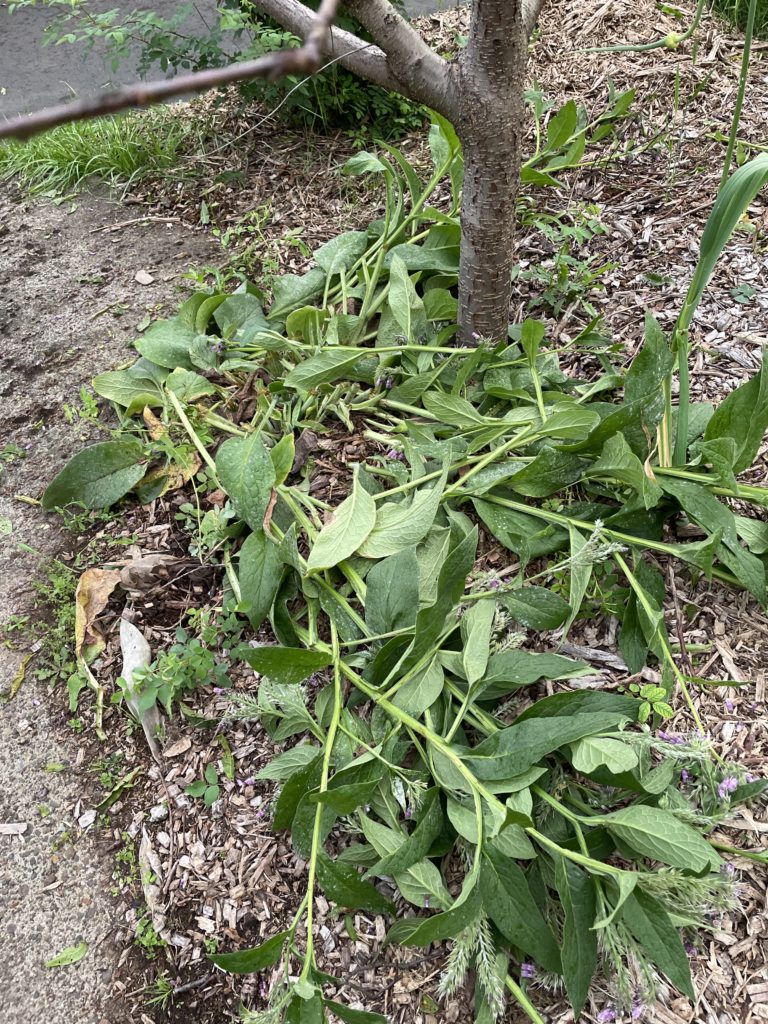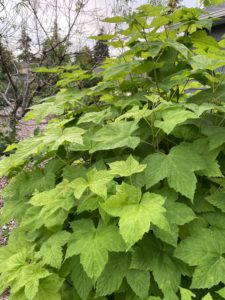The chop and drop technique in a food forest is a proven permaculture strategy for building a rich soil microbiome. Chop and drop is simply the concept of trimming plants and placing the cuttings on the ground to rot and compost in place. The most important element is placing the materials directly on the ground so they can compost and return to the soil and feed the next growth cycle of your plants.
What is chopping and dropping
The idea is super simple, cut things and place them on the ground. I don’t even know how you can make it a more complicated matter, but I am sure someone has. Cut excess growth and let it compost in place. That’s it.

Comfrey chopped and dropped below a peach tree in an urban backyard orchard.
Tools for Chop and Drop
I use my hands and break branches and toss them on the ground all the time, however using hand tools is ideal. A blade such as a machete or hori hori is good for most materials and a pair of loppers will cut through stems and woody debris. Whatever you have in your garden shed for maintaining your backyard orchard and vegetable garden will work for chopping and dropping.
Favorite Chop & Drop Hand Tools
Machete
A machete is my preferred tool for chopping plants like comfrey which is large and mature. It is the perfect tool for cutting down thickets of native shrubs and stands of mature jerusalem artichokes.
Hori Hori
I prefer a hori hori when doing precise cuts where I don’t feel comfortable swinging the machete. A machete is so efficient for large maintenance jobs, however not the best when around tender plants.
Pruning Loppers
Use loppers for branches and woody material.
Benefits of Chop and Drop in a Food Forest
Feeding Soil Microorganisms
The entire food web below the soil from worms, and millipedes, down to microscopic organisms and mycorrhizal fungi feed on the materials that are placed on the surface of the soil. The leafy green materials and the chunkier woody debris breaks down at various speeds. Thriving soil microbiology is directly tied to healthy plants and trees that produce nutritionally dense foods.
Protects the Soil
A layer of chop and drop material is excellent mulch if you do not have something like a wood chip mulch already on the soil. Mulch protects the soil from the sun causing it to dry out too fast. When the soil is able to retain its moisture due to a protective layer of mulch plants will thrive during the dry seasons.
Adds Organic Material to Soil
We add compost to our garden beds and food forests to increase the amount of organic material in the soil. Chop and dropping are composting in place it just happens slower and not in a pile. Over time, the amount of organic material will accumulate in your soil by embracing a continuous chop and drop strategy.
Best Chop & Drop Plants
Any plant or tree can be used for chop and dropping. Certainly, some materials may serve better purposes elsewhere, but if you have an excess of plant debris don’t hesitate to drop it and compost in place in your food forest.
Our Favorite Chop and Drop Plants
These just happen to be the plants that we have planted on our homestead that lend themselves nicely to being used as chop and drop plants for green mulching our food forest. Use what you have available and plentiful on your homestead. In permaculture circles, people talk a lot about specific plants like comfrey and while I included it in my list because it is a wonderful plant, if you can’t get it something else will certainly work.
In our gardens, we have several native plants that spread very aggressively. Thimbleberry and elderberry are wonderful plants, but these require routine maintenance in order to keep them in check in an urban setting. All of the material I cut from them ends back on the ground feeding the soil and creating an ecosystem. The birds and other wildlife love foraging and enjoying the spaces our gardens create which includes the rich soil layer they exploit as a food source.

Thimbleberries that get chopped and dropped annually.
Things to Avoid Chopping & Dropping
I like to avoid plants that are known to easily root such as Himalayan blackberry vines. This kind of material can still be used onsite in a traditional compost if you practice hot composting, but it is best to not chop and drop weeds that can root.

Avoid Blackberry Vines and Plants that Easily Root
Most weeds are excellent for chop and drop since you might be pulling them before they flower and go to seed anyway. I just pull them and drop them back on the ground and move on.
Have fun chopping and dropping throughout your food forest garden
It really is as simple as cutting a piece of plant. Next, place it on the ground. Lastly, move on to something else and let the soil organisms enjoy the leafy and woody material you just dropped.



Recent Comments